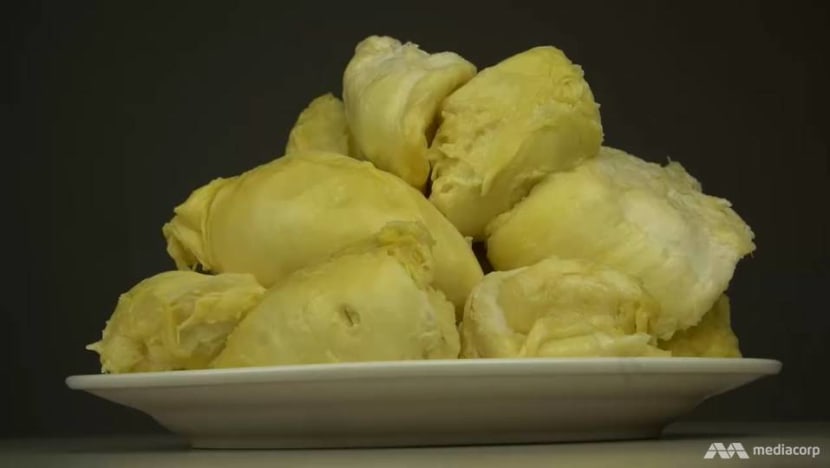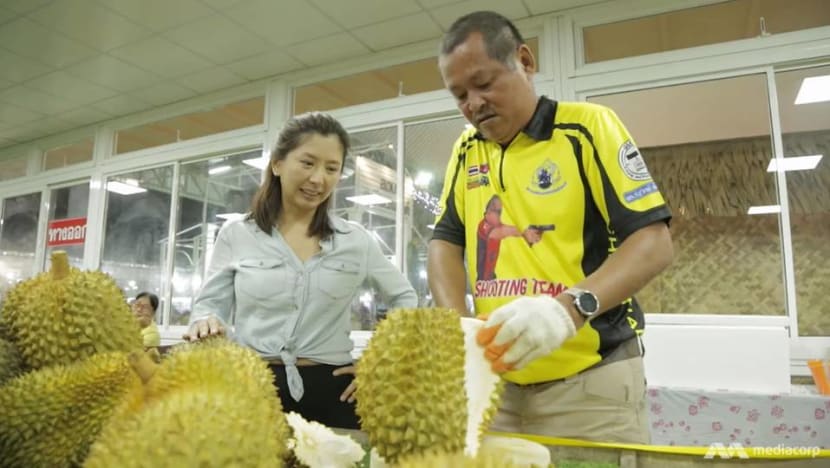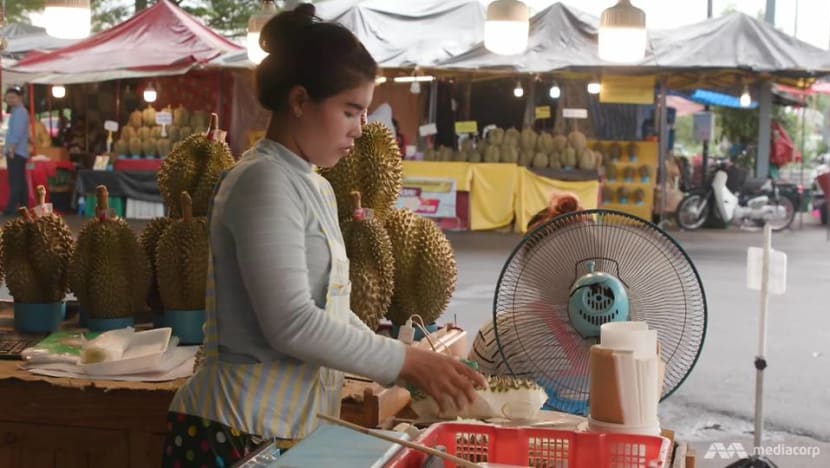How China’s love of durian is reshaping the Thai countryside
The king of fruits in this region is a new favourite in China, largely sourced from Thailand. But whether that is a blessing or a curse for the Southeast Asian country depends on who you ask.

A plate of durians. (Photo: Mediacorp)
CHANTHABURI, Thailand and GUANGZHOU, China: This restaurant’s signature dish is durian chicken pot. Its bestseller is spinach with durian fried rice. And it has many more of such dishes, like durian pickled vegetable fish.
The founder of Qing Liu Durian Restaurant in Guangzhou, China, discovered the thorny fruit when he travelled to Singapore, Malaysia and Thailand more than a decade ago.
Chen Zhenjiang found it “really tasty”, but many of his friends “wouldn’t touch raw durians”.
“They’d eat durian products, like durian cake, durian pastry and durian tarts. It made me think why folks who shun raw durians would eat durian products,” says the one-time chef for the Qatari royal family.
“So I opened this restaurant to make durian products for these people to try.”

There is no stink, he adds, because the fragrance goes into the food. And that is how he has been converting non-durian lovers — with “a little taste of durian products first”. “Many of my customers now love durians,” he says.
Not only his customers but China’s growing middle class has developed a taste for exotic fruits like durian. Between 2009 and 2017, the country’s fresh durian imports grew fourfold, from US$124 million (S$169 million) to US$552 million.
READ: Is the 'king of fruit' set to conquer the Chinese market?
Last year, the growth exploded as Chinese consumers spent US$1.1 billion, double the amount in 2017.
This was in no small part boosted by headlines about an Alibaba flash sale of Thai durians on its retail site, Tmall. Within the opening minute, 80,000 durians were snapped up.
Thailand is the only country allowed to export fresh whole durians directly to mainland China, thanks to a 2003 trade agreement. Of its annual output of around 600,000 tonnes, 70 per cent last year went to the Chinese market.
WATCH: China's billion-dollar love affair with durian (3:02)
The trade is even triggering a real estate boom in its durian heartland, the series China’s Growing Appetite discovers. But is its domination of the Chinese market a blessing or a curse for the Southeast Asian country?
DURIAN BONANZA
Thailand’s biggest durian-producing region is Chanthaburi, an eastern province that accounts for 1.2 per cent of the country’s land mass but nearly half of its durian output owing to its favourable soil and climate.
And more Chinese middlemen — from about 100 last year to more than 500 companies this year — are coming to do business, says Chalermpol Sakkham, the mayor of Tha Chang municipality in the province.
“They know how to export fruit to China. They’ll make everything right to meet the government standard,” he says, full of praise for the durian trade with China.
“It makes our lives better — not only the farmers in Chanthaburi but also the farmers who plant durians all over Thailand.”

Selling durians is so lucrative that it is prompting other farmers to jump on the bandwagon. The price of rubber has also slumped over the last few years, so rubber plantations are increasingly being replaced by durian trees.
Take, for example, Niwat Wongchanta and Jirakul Jetjumonong. The couple cut down their rubber trees five years ago to plant more than 100 durian trees, hoping to ride the tidal wave of Chinese demand.
“Everyone was enjoying success from planting durians. We also want to be like them. Durian is our hope,” says Jirakul.
Durian trees take a long time to mature, however, and they will reap their first fruits only next year. Niwat thinks they could get about a million baht (S$45,000) if all their trees produce durians.
While he used to worry that durian might suffer a similar fate as rubber, he now thinks the market “won’t die anytime soon”. His wife agrees: “There are many Chinese middlemen now, so we’re confident.”
Small farms like theirs, however, are becoming rare in Chanthaburi as mega plantations take over. Durian Land, for example, covers two square kilometres. And owner Chanogmon Viriyapanichpakdee would buy more land if it is nearby.

“But the price now is increasing so much,” she says. Land prices are two to three times higher than six years ago, and she herself has thrice had Chinese investors offering her triple what she paid for her plantation.
“In future I’ll get more,” she reckons.
Around the province, there are plots of land newly cleared for durian trees and also the packing houses run by Chinese middlemen.
These cash-rich businessmen go to the farms, scout for the best harvests, lock them in with an advance contract, hire workers for harvest time and export the durians to China.
For local middlemen, the competition is more intense than ever before. “Even if you have a lot of money, it’s easier to buy gold than to buy durians,” says Viroon Oonja, who has been in the business for 20 years.
“I still can run a business because I have a lot of friends, and I know farmers. We help each other find more durians.”

GAME CHANGERS
Someone else who has been in the durian business for a long time — 25 years — is Kanjana Yaemprai, the president of Queen Frozen Fruit. And when she introduced frozen durian to China three years ago, it was a game changer.
“We put a stick in it. So it’s easy to carry, easy to buy and easy to eat,” is how her assistant and nephew Pakpum Bhagpabhakorn describes their product that looks like ice lolly and “doesn’t smell that much”.
While frozen durians are not new, the company does a faster and deeper freeze (-60°C for eight hours) to reduce the ice crystals inside the fruit and give it a creamier texture.
This has boosted the popularity of frozen durian and made the fruit available all year round to the Chinese. And it offers a way to export lower-grade durians.
“We do contract farming, and we need to harvest all the fruits … in the farm,” says Pakpoom. “That’s why we built the factory … to make frozen durian.”
Last year, the company exported 160 containers of the frozen durian to China, or 1.12 million durians. “(Chinese buyers) would just say, ‘I’ll take all of whatever you have,’” he adds.
He is now “a bit” worried, however, because Malaysia has been allowed to export frozen whole durians directly to mainland China from this year.
WATCH: Malaysia can now export frozen whole durians to China (2:06)
“Nowadays, Chinese people know only about the Mao Shan Wang (or Musang King) durian,” he says. “We export much more than Musang King (suppliers do) to China, but (consumers) don’t know about the name of the durian from Thailand.”
Thailand’s main durian export is the Monthong (Golden Pillow) variety, but branding is a “weak point”, he admits. “Maybe next year, we’ll find a partner who can (create) a stronger brand for Thai durian.”
READ: Malaysia expects frozen durian exports to China to hit 1,000 metric tonnes monthly
With or without branding, however, the durian is now a symbol of affluence to the Chinese.
At the Jiangnan Fruit and Vegetable Market in Guangzhou, the price has risen from 55 yuan (S$10.70) a case to 480 yuan in the 20 years Peng Xueling has been selling durians.
“In the past, we sold 100 to 200 cases a day; now we sell 700 to 800,” she says. “A lot of people have accepted the taste of durian.”
In contrast, the Thais have tightened their belts. In the decade to 2017, their durian consumption fell to 20 per cent of what it used to be as farmers diverted local supply to exports.

At the Iyara market on the outskirts of Bangkok — one of the country's largest fresh fruit markets — durian seller Adisak Prangthaptim remembers how it was before China’s appetite started growing.
“The best durians cost 120 baht per kilogramme; the good-quality durians cost 60 to 80 baht,” he cites. “Now, lower-quality durians cost 200 baht; good-quality durians are exported to fetch higher prices.”
Lamenting the issue of local affordability, he adds: “More Chinese consumers eating durian benefits the farmers and the middlemen. But it’s bad for the retailer.”
As to whether Thai consumers are unhappy about buying durian less often, it depends on who you ask. As one of them says, “It’s okay because selling (durian) to other countries (means more) money coming in.”
Read about how the Amazon is left counting the cost of China's hunger for food. The final episode of China's Growing Appetite will air tonight, Nov 30, at 9pm.


















